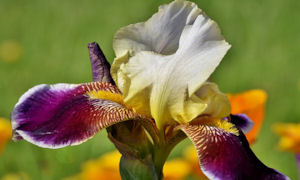Guide to Types of Iris
The Iris is at home in almost any garden design. Grow it in drifts for a traditional cottage garden look or use it sparingly for seasonal spots of colour in the gravel garden.
Irises come in all sorts of colours including blue, pink, purple, reddish, white, yellow and bi-colors. There is even one that is almost black. The blues, of course, are the most popular and most recognisable and, if you intend to include blues in your planting scheme, you've just got to have them.
Beared Irises get their name from the fuzzy patch or beard on the down-turned petals. They range in size from around 10cm to over a metre. Most bearded Irises flower between April and June so they're a great flower to cheer you up on the way to summer. They are a rhizomatous plant and should be planted so that the rhizome (thick fleshy root) sits no more than one 2 or 3cm beneath the surface. They will do best if the rhizome has full sun and is not shaded out by other plants. They prefer a free-draining soil otherwise the rhizome will rot.

Siberian Irises are much easier to grow and more tolerant of moist conditions than the beared types. They're not quite as showy but they, too, make good cut flowers. After flowering, their sword-like foliage remains for the rest of the growing season making it an ideal architechtural plant as well as one for the perennial border. Plant your Siberian Iris in a slightly acid, organic-rich soil. It also looks very much at home beside a pond or water feature.

The dwarf iris, Iris reticulata, blooms in early spring and looks great when mixed with dwarf narcissus or yellow crocus varieties. They are highly fragrant and very easy to grow.

Dutch Irises grow from a true bulb as opposed to a rhizome. They are long-lasting as cut flowers and naturalize fairly easily. Choose from a myriad of colours or buy a packet of mixed bulbs for a random look. Plant them in autumn or spring into a free-draining soil.

Whatever Irises your prefer, you should always plant them in groups of five or more for maximum effect. After a few years, you may find that flower quality is reduced. If you notice this happening, they are simply overcrowded and should be lifted and divided.
Clare is a landscaper and regular contributor to Gardenzine









